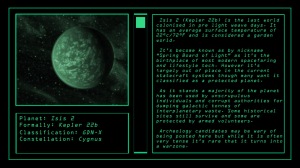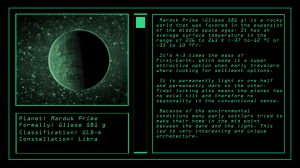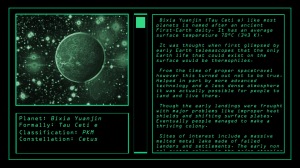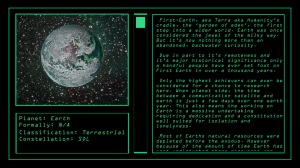While we must concede that the universe, in the story of AYT, will probably not be seen on screen; I (Patrick) have spent time making graphics for the Dean’s display screen that shows potential historical sites for our main character. These other worlds are loosely based on candidates that MAY be able to support life. I am going to show off these other worlds.
ISIS 2 – “Isis 2 (Kepler 22b) is the last world colonised in pre light weave days. It has an average surface temperature of 22°c/72°F and is considered a garden world.
It’s become known as by nickname “Spring Board of Light” as it’s the birthplace of most modern space faring and lifestyle tech. However it’s largely out of place in the current statecraft systems though many want it classified as a protected planet.
As it stands a majority of the planet has been used by unscrupulous individuals and corrupt authorities for dumping galactic tonnes of interplanetary waste. Some historical sites still survive and some are protected by armed volunteers.
Archeology candidates may be wary of being posted here but while it is often very tense it’s rare that it turns into a war zone.”
Marduk Prime – ” Marduk Prime (Gliese 581 g) is a rocky world that was favored in the expansion of the middle space ages. It has an average surface temperature in the range of 236 to 261 K (−37 to−12 °C or −35 to 10 °F).
It’s 4.3 times the mass of First-Earth, which made it a super attractive option when early travelers where looking for settlment options.
It is permanently light on one half and permanently dark on the other. Tidal locking also means the planet has no axial tilt and therefore no seasonality in the conventional sense.
Because of the environmental conditions many early settlers tried to make their home in the mid point between the dark and the light. This led to very interesting and unique architecture.”
Bixia Yuanjin – “Bixia Yuanjin (Tau Ceti e) like most planets is named after an ancient First-Earth deity. It has an average surface temperature 70°C (343 K).
It was thought when first glimpsed by early Earth telescopes that the only Earth life that could exist on the surface would be thermophiles.
From the time of proper spacetravel however this turned out not to be true. Helped in part by more advanced technology and a less dense atmosphere it was actually possible for people to land and live there.
Though the early landings were frought with major problems like improper heat shields and shifting surface plates. Eventually people managed to make a thriving colony.
Sites of interest include a massive melted metal lake made of failed landers and settlements. The early non sol system colony is the major stepping stone to the expansion of the rest of the galaxy.”
Mars – “Mars is the most colonised of planets humans ever lived on, due to its close proximity to First-Earth. Mars was called the first step into a wider world. Before it was colonised and terraformed the Martian surface temperatures vary from lows of about −143 °C (at the winter polar caps) to highs of up to 35 °C (in equatorial summer).
The wide range in temperatures was due to the thin atmosphere which couldn’t store much solar heat, the low atmospheric pressure, and the low thermal inertia of Martian soil.
Mars has become a very distant but important historical planets, second only to Earth itself. As humanity expanded outward into the rest of the galatic table, Mars became largely abandoned; though archeologists sent here occasionally tell of encounters with odd humanoid creatures.
The United Aerospace Corp managed establish a major mining base on the moons, Phobos and Deimos. Though something catastrophic happened and no one heard from either moon again. Ships sent here never came back and the moons became quarantined.”
Earth – “First-Earth, aka Terra aka Humanity’s cradle, the ‘garden of Eden’. Earth was once considered the jewel of the milky way. But it’s now nothing more than an abandoned, backwater curiosity.
Due in part to it’s remoteness and it’s major historical significance only a handful people have ever set foot on First Earth in over a thousand years.
Only the highest achievers can ever be considered for a chance to research here. When planet side, the time between a communication satellite and earth is just a few days over one earth year. This also means that working on Earth is a massive undertaking requiring dedication and a constitution well suited for isolation and loneliness.
Most of Earth’s natural resources were depleted before the exodus. However because of the amount of time Earth has went undisturbed these resources are beginning to reach mine-able levels again. This has some conservationists and archeologists worried that it might make it a target for rogue enterprises trying to consume those resources for profit.”
In the story design, Earth is one of the furthest planets from the current seat of humanity. There’s a few references to a larger universe but I tried to stay away from being very specific.






